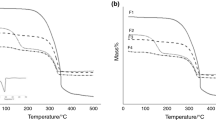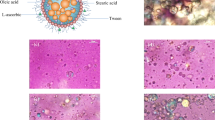Abstract
This research aimed to study the correlation between miscibility of flutamide (FLT), lipids and surfactant on the particle size of solid lipid nanoparticles (SLNs). Physical mixtures (PMs) of lipids-glyceryl monooleate (GMO), Precirol® (glyceryl palmitostearate, PRE), glyceryl monostearate (GMS), and Compritol® (glyceryl dibehenate, COM) were prepared with surfactant-Gelucire® (stearoyl polyoxyl-32 glycerides, GEL) 50/13 and 44/14. PMs were prepared in 5:2 w/w ratio (lipid:surfactant) and 2:1 w/w (Flutamide (FLT):lipids/GEL 50/13) by co-melting. Miscibility of PMs was investigated using modulated differential scanning calorimetry (MDSC). SLNs with and without drug were prepared using GEL 50/13 by the ultra-sonication method and particle size analysis was conducted. PMs of GMO, GMS, and PRE with both surfactants showed a decrease in the melting temperature, no change in melting and crystallization peak was observed with COM-GELs, indicating immiscibility. Similarly, MDSC data suggests good miscibility of FLT in GMO, GMS, and GEL 50/13 but not in PRE and COM. The particle size of drug-loaded SLNs prepared from GMO and GMS with GEL 50/13 was found to be 70.2 ± 5.4 and 92.6 ± 8.5 compared to > 200-nm particles obtained from PRE and COM. On lyophilization, an increase in particles size was observed with COM only. The particle size of SLNs with PRE and COM was prominently increased during stability studies indicating SLNs prepared with GMO and GMS are more stable due to miscibility and ability to reduce the crystallinity of FLT. The results established a good correlation between drug, lipids, and surfactants miscibility to the obtained particle size of SLNs before and after lyophilization.

Graphical Abstract






Similar content being viewed by others
References
Verma A, Singh M, Kumar B. Development and characterization of Flutamide containing self micro emulsifying drug delivery system (SMEDDS). Int J Pharm Pharm Sci. 2011;3(4):60–5.
Jeevana JB, Sreelakshmi K. Design and evaluation of self-nanoemulsifying drug delivery system of flutamide. J Young Pharm: JYP. 2011;3(1):4.
Chauhan H, Kuldipkumar A, Barder T, Medek A, Gu C-H, Atef E. Correlation of inhibitory effects of polymers on indomethacin precipitation in solution and amorphous solid crystallization based on molecular interaction. Pharm Res. 2014;31(2):500–15.
Chauhan H, Hui-Gu C, Atef E. Correlating the behavior of polymers in solution as precipitation inhibitor to its amorphous stabilization ability in solid dispersions. J Pharm Sci. 2013;102(6):1924–35.
Meng F, Gala U, Chauhan H. Classification of solid dispersions: correlation to (i) stability and solubility (ii) preparation and characterization techniques. Drug Dev Ind Pharm. 2015;41(9):1401–15.
Meng F, Trivino A, Prasad D, Chauhan H. Investigation and correlation of drug polymer miscibility and molecular interactions by various approaches for the preparation of amorphous solid dispersions. Eur J Pharm Sci. 2015;71:12–24.
Prasad D, Chauhan H, Atef E. Role of molecular interactions for synergistic precipitation inhibition of poorly soluble drug in supersaturated drug–polymer–polymer ternary solution. Mol Pharm. 2016;13(3):756–65.
Prasad D, Chauhan H, Atef E. Amorphous stabilization and dissolution enhancement of amorphous ternary solid dispersions: combination of polymers showing drug–polymer interaction for synergistic effects. J Pharm Sci. 2014;103(11):3511–23.
Chauhan H, Mohapatra S, Munt DJ, Chandratre S, Dash A. Physical-chemical characterization and formulation considerations for solid lipid nanoparticles. AAPS PharmSciTech. 2016;17(3):640–51.
Patel J, Amrutiya J, Bhatt P, Javia A, Jain M, Misra A. Targeted delivery of monoclonal antibody conjugated docetaxel loaded PLGA nanoparticles into EGFR overexpressed lung tumour cells. J Microencapsul. 2018;35(2):204–17.
Yewale C, Baradia D, Patil S, Bhatt P, Amrutiya J, Gandhi R, et al. Docetaxel loaded immunonanoparticles delivery in EGFR overexpressed breast carcinoma cells. J Drug Delivery Sci Technol. 2018;45:334–45.
Bhatt P, Lalani R, Mashru R, Misra A. Anti-FSHR antibody Fab’fragment conjugated immunoliposomes loaded with cyclodextrin-paclitaxel complex for improved in vitro efficacy on ovarian cancer cells. AACR; 2016.
Jabir NR, Tabrez S, Ashraf GM, Shakil S, Damanhouri GA, Kamal MA. Nanotechnology-based approaches in anticancer research. Int J Nanomedicine. 2012;7:4391.
Sultana S, Khan MR, Kumar M, Kumar S, Ali M. Nanoparticles-mediated drug delivery approaches for cancer targeting: a review. J Drug Target. 2013;21(2):107–25.
Licciardi M, Di Stefano M, Craparo EF, Amato G, Fontana G, Cavallaro G, et al. PHEA-graft-polybutylmethacrylate copolymer microparticles for delivery of hydrophobic drugs. Int J Pharm. 2012;433(1–2):16–24.
Murthy R, Umrethia ML. Optimization of formulation parameters for the preparation of flutamide liposomes by 33 factorial 26-term logit model. Pharm Dev Technol. 2005;9(4):369–77.
Elgindy N, Elkhodairy K, Molokhia A, Elzoghby A. Lyophilization monophase solution technique for preparation of amorphous flutamide dispersions. Drug Dev Ind Pharm. 2011;37(7):754–64.
Raymond C Rowe PJSaMEQ. Handbook of pharmaceutical excipients. 6 ed2009.
Martin AN. Martin’s physical pharmacy and pharmaceutical sciences: physical chemical and biopharmaceutical principles in the pharmaceutical sciences: Lippincott Williams & Wilkins; 2006.
Bandari S, Jadav S, Eedara BB, Dhurke R, Jukanti R. Enhancement of solubility and dissolution rate of loratadine with gelucire 50/13. J Pharm Innov. 2014;9(2):141–9.
Benita S. Submicron emulsions in drug targeting and delivery: CRC Press; 1998.
Wong HL, Bendayan R, Rauth AM, Li Y, Wu XY. Chemotherapy with anticancer drugs encapsulated in solid lipid nanoparticles. Adv Drug Deliv Rev. 2007;59(6):491–504.
Zhang H, Huang X, Mi J, Huo Y, Wang G, **ng J, et al. Improvement of pulmonary absorptions of poorly absorbable drugs using G elucire 44/14 as an absorption enhancer. J Pharm Pharmacol. 2014;66(10):1410–20.
Moghimi SM, Hunter AC, Murray JC. Long-circulating and target-specific nanoparticles: theory to practice. Pharmacol Rev. 2001;53(2):283–318.
Doijad R, Manvi F, Godhwani D, Joseph R, Deshmukh N. Formulation and targeting efficiency of cisplatin engineered solid lipid nanoparticles. Indian J Pharm Sci. 2008;70(2):203.
Goutayer M, Dufort S, Josserand V, Royère A, Heinrich E, Vinet F, et al. Tumor targeting of functionalized lipid nanoparticles: assessment by in vivo fluorescence imaging. Eur J Pharm Biopharm. 2010;75(2):137–47.
Reddy LH, Sharma R, Chuttani K, Mishra A, Murthy R. Influence of administration route on tumor uptake and biodistribution of etoposide loaded solid lipid nanoparticles in Dalton’s lymphoma tumor bearing mice. J Control Release. 2005;105(3):185–98.
Yuan Q, Han J, Cong W, Ge Y, Ma D, Dai Z, et al. Docetaxel-loaded solid lipid nanoparticles suppress breast cancer cells growth with reduced myelosuppression toxicity. Int J Nanomedicine. 2014;9:4829.
Gaur PK, Mishra S, Bajpai M, Mishra A. Enhanced oral bioavailability of efavirenz by solid lipid nanoparticles: in vitro drug release and pharmacokinetics studies. Biomed Res Int. 2014;2014:9.
Author information
Authors and Affiliations
Corresponding author
Additional information
Guest Editors: Mahavir Bhupal Chougule, Vijaykumar B. Sutariya and Sudip K. Das
Publisher’s Note
Springer Nature remains neutral with regard to jurisdictional claims in published maps and institutional affiliations.
Rights and permissions
About this article
Cite this article
Trivino, A., Gumireddy, A. & Chauhan, H. Drug-Lipid-Surfactant Miscibility for the Development of Solid Lipid Nanoparticles. AAPS PharmSciTech 20, 46 (2019). https://doi.org/10.1208/s12249-018-1229-3
Received:
Accepted:
Published:
DOI: https://doi.org/10.1208/s12249-018-1229-3




